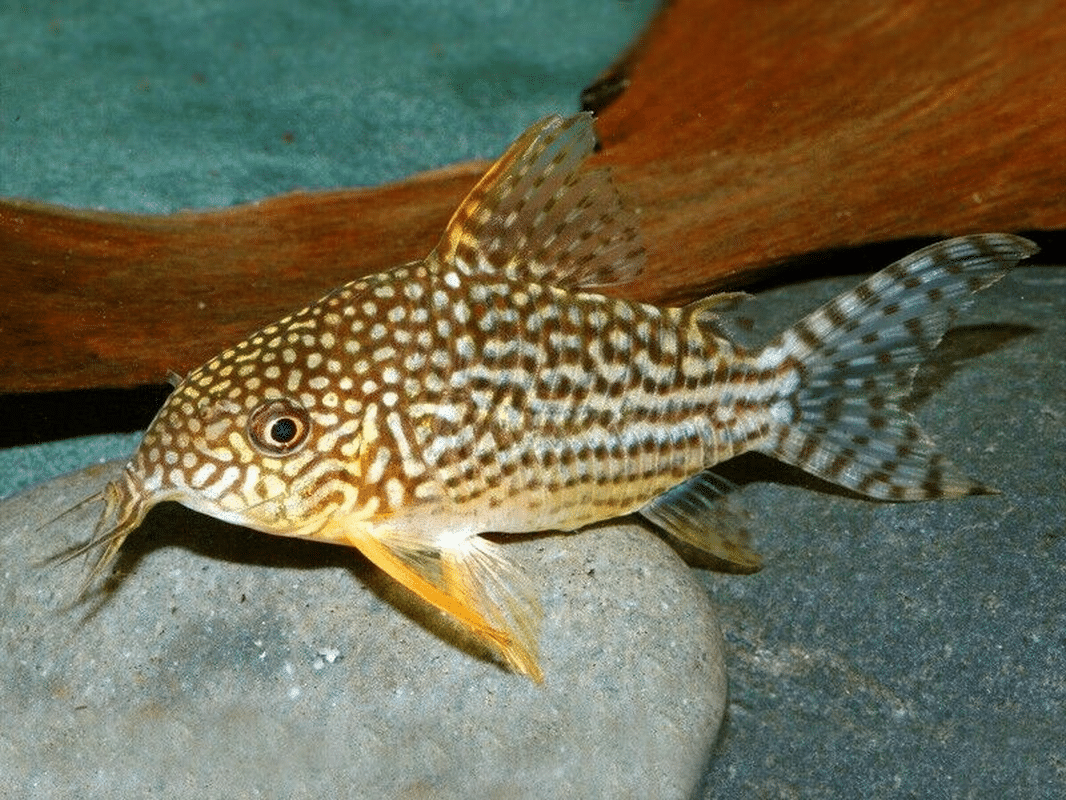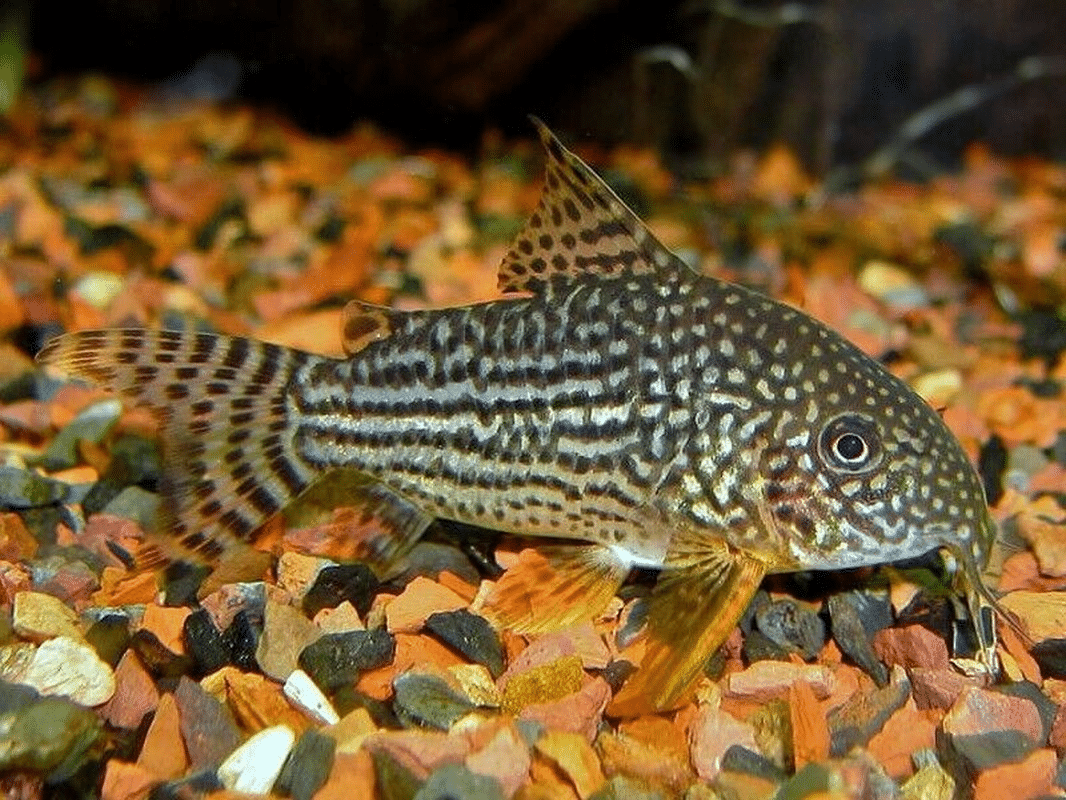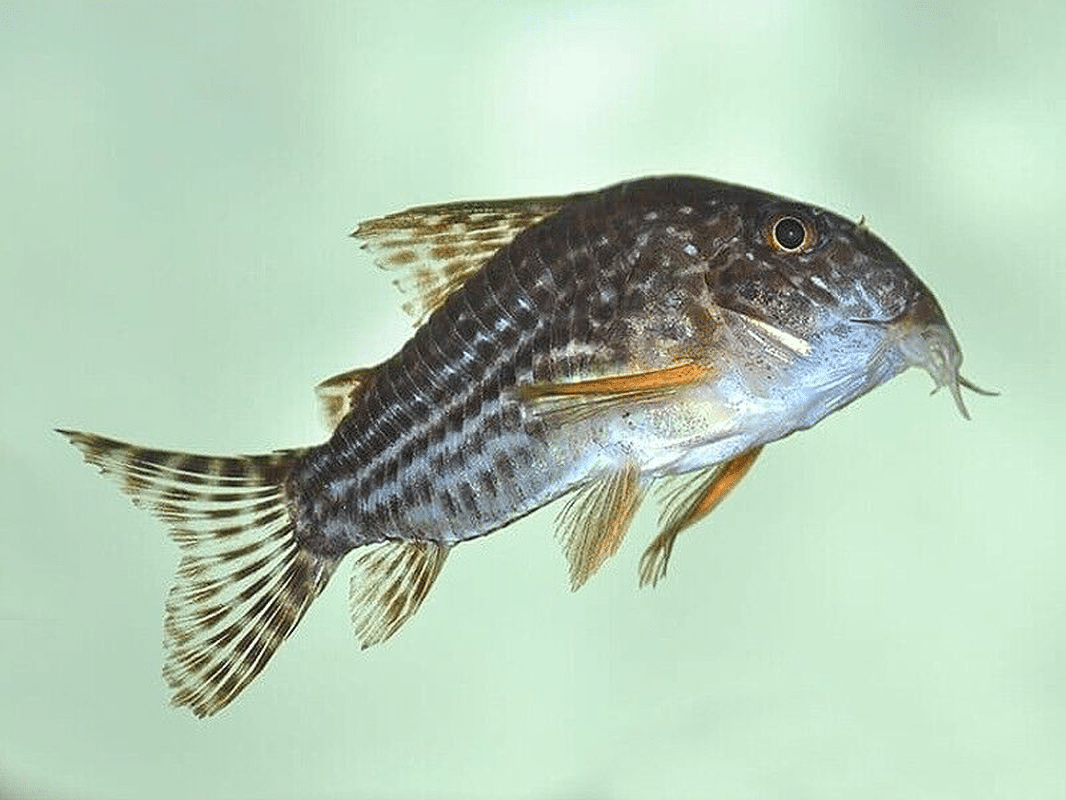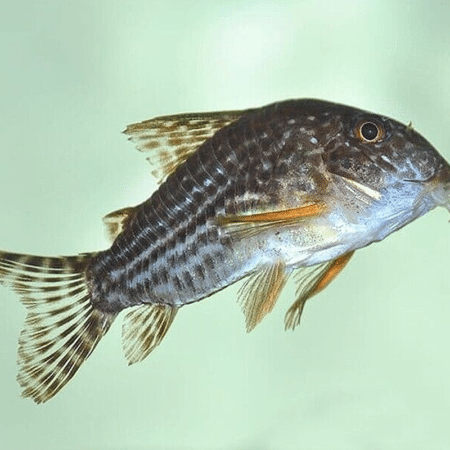Subtotal: £25.16
Sterba’S Cory – Corydoras Sterbai – Rio Guaporé Cory – South American Catfish, Stunning Addition to Planted Aquariums, Ideal for Beginners Focused on Community Fish Care
£13.99 Original price was: £13.99.£11.61Current price is: £11.61.
Welcome these beautiful Sterba’s Cory, also known as Corydoras Sterbai, to your aquarium! With their striking patterns and playful nature, these South American catfish thrive in groups. Perfect for community tanks, they create a lively atmosphere while scavenging for food and interacting gracefully with other fish.
4001 in stock
Species Introduction
Welcome these beautiful creatures, scientifically known as Corydoras sterbai. This charming species hails from the Rio Guaporé region in South America, where it thrives in the slow-moving waters of rivers and streams. Sterba’s Cory is a small catfish that typically reaches a maximum length of about 2.5 inches (6.4 cm). They are characterized by their distinctive coloration, featuring a golden-brown body adorned with black spots and a striking white belly. This unique appearance, combined with their peaceful demeanor, makes them a beloved choice for aquarium enthusiasts.
As scavenger fish, they play a vital role in their natural habitat by helping to keep the substrate clean, feeding on detritus and leftover food. In your aquarium, they will continue this behavior, contributing to a balanced ecosystem.
Care Requirements Dashboard
Essential Care Guide for Your Sterba’S Cory
| Optimal Living Conditions | |
|---|---|
| Water Temperature | 22-28°C (72-82°F) |
| pH Level | 6.0-7.5 |
| Water Hardness | 2-15 dKH |
| Minimum Tank Size | 120L (30 gal) |
| Salinity | Freshwater |
| Care Level | Beginner to Intermediate |
Natural Behavior & Temperament
Sterba’s Corys are known for their gentle and sociable nature, making them ideal additions to community tanks. They are bottom-dwellers that enjoy foraging through the substrate, searching for food and exploring their environment. Their natural behavior includes swimming in small groups, which not only provides them with a sense of security but also enhances their overall well-being. In the wild, these fish exhibit a range of social interactions, often seen darting about in playful displays or resting together in shaded areas. In an aquarium setting, they thrive in groups of at least six, as this mimics their natural schooling behavior and helps reduce stress. Observing their interactions can be a delightful experience, as they communicate through subtle body language and playful antics.
Tank Setup Guide
Creating an ideal environment for your Sterba’s Cory involves replicating their natural habitat as closely as possible. Start with a spacious tank of at least 20 gallons, as these fish appreciate room to swim and explore. The substrate should be soft, such as fine sand or smooth gravel, to prevent injury to their delicate barbels. Incorporate plenty of hiding spots using driftwood, caves, and live plants, as these elements provide security and mimic their natural surroundings. Aquatic plants like Java Fern and Anubias not only enhance the aesthetic appeal of the tank but also offer additional cover. Ensure that the tank is well-cycled and maintain stable water parameters to promote the health of your aquatic companions. Regular water changes and a good filtration system are essential to keep the environment clean and safe.
Water Quality Management
Maintaining optimal water quality is crucial for the health and longevity of your Sterba’s Cory. They thrive in slightly acidic to neutral water, with a pH level ranging from 6.0 to 7.5. Regular testing of water parameters is essential, as fluctuations can lead to stress and health issues. The ideal water temperature should be kept between 75-82°F (24-28°C), mimicking their natural tropical environment. Additionally, the water hardness should be maintained within the range of 2-15 dGH. To ensure a stable environment, perform regular water changes of 20-30% weekly, and utilize a high-quality filter to help maintain clarity and remove toxins. Monitoring ammonia, nitrite, and nitrate levels is also vital, as elevated levels can be harmful to your fish friends.
Feeding & Nutrition
Sterba’s Cory are omnivorous scavengers, and their diet should reflect this diversity. A balanced diet consists of high-quality sinking pellets, flakes, and frozen or live foods such as bloodworms and brine shrimp. It is essential to provide a varied diet to ensure they receive all necessary nutrients for optimal health. Feed them small amounts 2-3 times a day, only what they can consume in a few minutes to prevent overfeeding and maintain water quality. Additionally, incorporating vegetable matter, such as blanched zucchini or spinach, can enhance their diet and promote digestive health. Keep an eye on their feeding behavior, as these fish are social eaters and often enjoy foraging together, which can be a delightful sight in your aquarium.
Compatibility Guide
✓ Peaceful Community Fish
| Tank Mate | Compatibility |
|---|---|
| Neon Tetra | Excellent |
| Guppy | Good |
| Angelfish | Caution |
| Betta | Not Recommended |
Sterba’s Cory are generally peaceful and get along well with many community tank fish. Ideal tank mates include small, non-aggressive species such as Neon Tetras and Guppies. However, caution should be exercised with larger or more aggressive fish, such as Angelfish, which may view them as potential prey. It is advisable to avoid keeping them with fin-nippers like Bettas, as their long fins can provoke stress and aggression. Always monitor interactions between species to ensure a harmonious environment, and consider the size and temperament of all fish when selecting tank mates.
Health & Wellness
Maintaining the health of your Sterba’s Cory requires vigilance and proactive care. Common health issues include ich, fin rot, and bacterial infections, often resulting from poor water quality or stress. Regular water changes, proper filtration, and stable water parameters are critical in preventing these issues. Observe your fish for any signs of distress, such as scratching against objects, lethargy, or changes in appetite. If health problems arise, it is essential to isolate the affected fish and treat them in a hospital tank to prevent the spread of disease. Additionally, providing a stress-free environment with plenty of hiding spots can significantly enhance their overall well-being. Regularly check for signs of good health, such as vibrant coloration and active behavior, to ensure your aquatic companions are thriving.
Breeding Information
Breeding Sterba’s Cory can be a rewarding experience for aquarists willing to provide the right conditions. To encourage spawning, it is essential to mimic their natural breeding environment by maintaining excellent water quality and slightly cooler temperatures. A separate breeding tank with soft, slightly acidic water is ideal. Introduce a group of at least six Sterba’s Cory, as they are social spawners. The female will lay eggs on flat surfaces, such as leaves or spawning mats, and the male will fertilize them. After a few days, the eggs will hatch into fry. It is crucial to provide infusoria or finely crushed flakes for the fry to ensure proper growth and development. As they grow, gradually introduce larger food items to accommodate their dietary needs.
Acclimation Process
When introducing Sterba’s Cory to your aquarium, it is essential to acclimate them properly to minimize stress and ensure a smooth transition. Start by floating the sealed bag containing your new fish in the aquarium for about 15-20 minutes to equalize the temperature. After this, gradually introduce small amounts of tank water into the bag over the next hour. This process helps the fish adjust to the water parameters of their new home. Once acclimated, gently release them into the tank using a net, avoiding adding bag water to your aquarium. Monitor their behavior closely for the first few days, ensuring they are settling in well and adjusting to their new surroundings.
Long-term Care
Sterba’s Cory can live for several years with proper care, making them a long-term commitment for any aquarist. To ensure their health and happiness, maintain a stable environment with consistent water parameters and a balanced diet. Regularly monitor their behavior and health, addressing any issues promptly. As they grow, be mindful of their social dynamics, ensuring they are kept in groups to promote their natural behavior. Regular tank maintenance, including cleaning and water changes, will help maintain a healthy ecosystem for your fish friends. With attentive care, these beautiful creatures can thrive and bring joy to your aquarium for years to come.
Natural Habitat Recreation
Recreating the natural habitat of Sterba’s Cory in your aquarium not only enhances their well-being but also enriches the overall aesthetic of your tank. Aim to replicate the slow-moving waters of the Rio Guaporé by incorporating elements such as driftwood, rocks, and live plants. A sandy substrate will mimic the riverbed, allowing them to forage naturally. Position plants to create shaded areas and hiding spots, which will help them feel secure and reduce stress. Additionally, consider using a gentle filter to maintain water movement without creating strong currents, as Sterba’s Cory prefer calm waters. By carefully designing their environment, you can create a thriving habitat that reflects their natural surroundings.
Seasonal Care Adjustments
As the seasons change, so too may the needs of your Sterba’s Cory. During warmer months, ensure that the water temperature remains stable and does not exceed 82°F (28°C). Consider using a fan or aquarium chiller if necessary. In colder months, maintain the temperature within the recommended range by utilizing a reliable heater. Additionally, monitor the water parameters more frequently during seasonal transitions, as fluctuations can occur. Adjust your feeding schedule based on their activity levels; during warmer months, they may be more active and require slightly more food. By being attentive to these seasonal changes, you can provide optimal care for your aquatic companions year-round.
Expert Tips
For those looking to enhance their care for Sterba’s Cory, consider these expert tips: First, maintain a well-planted tank to provide hiding spots and reduce stress. Utilize a sponge filter to ensure gentle water flow, which is ideal for these bottom-dwellers. Additionally, consider adding leaf litter or Indian almond leaves to the tank, as they can help mimic their natural environment and provide beneficial tannins. Regularly observe your fish for signs of health and behavior changes, as early detection of issues can lead to more effective treatment. Lastly, engage with fellow aquarists to share experiences and tips, as community knowledge can greatly enhance your understanding of these beautiful creatures.
Troubleshooting
In the event of common issues with your Sterba’s Cory, it is essential to approach troubleshooting with care. If you notice signs of stress, such as hiding excessively or a lack of appetite, first check the water parameters to ensure they are within the recommended ranges. If the fish are exhibiting signs of illness, such as white spots or frayed fins, consider isolating the affected individuals and treating them in a hospital tank. Always maintain good hygiene practices, such as regular water changes and substrate cleaning, to prevent the buildup of harmful bacteria. If problems persist, consult with an aquatic veterinarian or a knowledgeable aquarist to determine the best course of action.
Scientific Background
Sterba’s Cory, or Corydoras sterbai, belongs to the family Callichthyidae, which includes a variety of armored catfish species. These fish are characterized by their bony plates, which provide protection against predators in their natural habitat. Research on Corydoras species has revealed their importance in freshwater ecosystems, as they contribute to the health of the substrate and help maintain water quality by consuming detritus. Conservation efforts are crucial for preserving their natural habitats, as pollution and habitat destruction pose significant threats. By caring for Sterba’s Cory in your aquarium, you are not only enjoying their beauty but also contributing to the awareness and appreciation of these remarkable fish.
Advanced Care Techniques
For advanced aquarists looking to provide exceptional care for Sterba’s Cory, consider implementing techniques such as creating a biotope aquarium that closely resembles their natural habitat. This involves selecting specific plants, substrates, and decorations that reflect the Rio Guaporé ecosystem. Additionally, consider using a breeding box or separate tank for spawning, as this can help increase the chances of successful reproduction. Regularly monitor water parameters using high-quality test kits, and consider utilizing a UV sterilizer to help control harmful pathogens. Engaging in regular research and staying updated on the latest advancements in aquarium care will enhance your ability to provide a thriving environment for your Sterba’s Cory.
Water Quality Parameters
Optimal Range
24-27°C
6.5-7.5
0 ppm
Caution Zone
22-24°C or 27-29°C
6.0-6.5 or 7.5-8.0
0.25-0.5 ppm
Danger Zone
<22°C or >29°C
<6.0 or >8.0
>0.5 ppm
Monitoring Tip: Test water parameters weekly and perform regular water changes to maintain optimal conditions for your aquatic friends!
Frequently Asked Questions
Q: What tank size is required for Sterba’s Cory?
Sterba’s Cory, or Corydoras Sterbai, thrive best in tanks of at least 75 litres (20 gallons). This size allows for adequate swimming space and a stable environment, which is crucial for their well-being. They are social fish and prefer to be kept in groups of at least six individuals, so a larger tank will help accommodate their social behaviour. A well-planted aquarium with ample hiding spots will also provide a sense of security. If you plan to introduce other species, consider their space requirements as well, ensuring all inhabitants have sufficient room to thrive.
✓ Expert Tip
Opt for a longer tank rather than a taller one, as Sterba’s Cory prefer to swim horizontally.
Q: What water parameters do Sterba’s Cory require?
For optimal health, Sterba’s Cory prefer slightly acidic to neutral water, with a pH range of 6.0 to 7.5. The water hardness should be between 2-15 dGH, and a temperature range of 24-28°C (75-82°F) is ideal. Regular water changes of 20-30% weekly will help maintain stable water quality. Using a reliable water testing kit will allow you to monitor these parameters accurately. Remember, sudden changes in water chemistry can stress these fish, so make adjustments gradually.
✓ Expert Tip
Consider using a sponge filter to maintain gentle water flow, as Sterba’s Cory prefer calmer waters.
Q: How often should I feed Sterba’s Cory?
Sterba’s Cory should be fed twice daily, providing them with small amounts of food that they can consume within a few minutes. A varied diet is essential for their health, including high-quality sinking pellets, frozen or live foods such as bloodworms, and vegetable matter like blanched peas or spinach. Overfeeding can lead to poor water quality, so it is crucial to monitor their intake. Adjust the quantity based on the number of fish and their activity levels.
✓ Expert Tip
Introduce food at different locations in the tank to encourage natural foraging behaviour.
Q: What are the best tank mates for Sterba’s Cory?
Sterba’s Cory are peaceful fish, making them excellent companions for a community tank. Ideal tank mates include small to medium-sized fish such as tetras, rasboras, and guppies. Avoid aggressive or larger species that may bully them. Ensure all fish are compatible in terms of size and temperament. A well-planned community aquarium with plenty of hiding spots will help maintain harmony among the inhabitants.
✓ Expert Tip
Consider adding other Corydoras species for a diverse and engaging tank environment.
Q: How do I properly acclimatise Sterba’s Cory to my aquarium?
Acclimatisation is vital for the health of your Sterba’s Cory. Begin by floating the sealed bag in your aquarium for about 15-20 minutes to equalise the temperature. Next, gradually introduce small amounts of tank water into the bag every 5 minutes for around an hour. Finally, gently transfer the fish into the aquarium using a net, discarding the bag water to prevent introducing any contaminants. This slow acclimatisation helps reduce stress and ensures the fish adapt well to their new environment.
✓ Expert Tip
Always acclimatise new fish during low light hours to reduce stress levels.
Q: What are the signs of healthy Sterba’s Cory?
Healthy Sterba’s Cory exhibit vibrant colours, clear eyes, and active behaviour. They should swim actively and engage in social interactions with their tank mates. Look out for their characteristic behaviour of foraging along the substrate. Signs of stress or illness include lethargy, loss of appetite, clamped fins, or changes in colour. Regular observation will help you catch potential health issues early, allowing you to take appropriate action.
✓ Expert Tip
Maintain a stable environment to promote their overall health and reduce stress.
Q: How do I successfully breed Sterba’s Cory?
Breeding Sterba’s Cory can be a rewarding experience. To encourage spawning, maintain a separate breeding tank with soft, slightly acidic water and provide plenty of hiding spots. Introduce a group of six or more individuals, as they prefer to breed in groups. A slight temperature increase and increased water changes can stimulate breeding behaviour. Once eggs are laid on flat surfaces, remove the adults to prevent them from eating the eggs. The eggs will hatch in 3-5 days, and the fry can be fed infusoria or finely crushed flakes.
✓ Expert Tip
Ensure good water quality during breeding to increase fry survival rates.
Q: What temperature should I maintain for Sterba’s Cory?
The ideal temperature range for Sterba’s Cory is between 24-28°C (75-82°F). Maintaining a stable temperature within this range is crucial for their health and activity levels. Sudden temperature fluctuations can lead to stress and compromise their immune systems. Use a reliable aquarium heater and thermometer to monitor the conditions accurately. Regular checks will ensure that your fish friends remain comfortable and healthy.
✓ Expert Tip
Consider a temperature controller for precise regulation, especially during seasonal changes.
Q: How long do Sterba’s Cory typically live in captivity?
In a well-maintained aquarium, Sterba’s Cory can live up to 5-7 years, sometimes even longer with optimal care. Factors such as water quality, diet, and tank conditions play a significant role in their lifespan. Regular water changes, a balanced diet, and a stress-free environment will help ensure they live a long and healthy life. Providing them with proper companions and enriching their habitat will also contribute to their longevity.
✓ Expert Tip
Keep a journal of water parameters and care routines to spot any trends that may affect their health.
Q: What type of substrate is most suitable for Sterba’s Cory?
Sterba’s Cory prefer fine, smooth substrates such as sand or small gravel. This type of substrate allows them to forage comfortably without damaging their delicate barbels. Avoid sharp substrates, as they can injure their sensitive skin. A layer of sand also mimics their natural habitat, allowing beneficial bacteria to thrive. Additionally, incorporating leaf litter or smooth stones can enhance their environment and provide hiding spots.
✓ Expert Tip
Rinse the substrate thoroughly before adding it to the tank to remove any dust or debris.
Q: What behavioural patterns should I expect from Sterba’s Cory?
Sterba’s Cory are social and inquisitive fish, often found foraging along the bottom of the tank in groups. They exhibit playful behaviour, darting around the aquarium and interacting with one another. You may observe them occasionally resting or hiding amongst plants or decorations, which is completely normal. They are also known to be bottom dwellers, spending a lot of their time searching for food. Providing ample hiding spots will encourage their natural behaviours and reduce stress.
✓ Expert Tip
Introduce new decorations or plants periodically to stimulate their curiosity and keep them engaged.
Q: How can I prevent common diseases in Sterba’s Cory?
Preventing diseases in Sterba’s Cory begins with maintaining excellent water quality. Regular water changes, proper filtration, and monitoring parameters are essential. Quarantining new fish before introducing them to the main tank can prevent the spread of illnesses. Additionally, ensuring a varied diet rich in nutrients strengthens their immune systems. Observing your fish regularly for signs of stress or illness will allow you to act swiftly if problems arise.
✓ Expert Tip
Maintain a stress-free environment to bolster their natural defence against diseases.
Q: What lighting conditions do Sterba’s Cory prefer?
Sterba’s Cory prefer moderate lighting, as overly bright conditions can cause stress. They thrive in tanks with plenty of plants that provide shaded areas, allowing them to feel secure. A balanced lighting schedule of around 10-12 hours a day will support plant growth while not overwhelming your fish friends. Additionally, using subdued light can enhance their colours and encourage natural behaviours.
✓ Expert Tip
Consider using floating plants to diffuse light and create a more natural environment.
Q: How do I recognise stress in Sterba’s Cory?
Signs of stress in Sterba’s Cory include hiding excessively, clamped fins, and erratic swimming patterns. If they are not eating or displaying unusual colour changes, it may indicate stress or illness. Additionally, observe their interactions with tank mates; aggression or bullying from others can lead to stress. Maintaining stable water parameters and a peaceful community will help minimise stress levels.
✓ Expert Tip
Provide plenty of hiding spots to give your fish friends a sense of security.
Q: What natural habitat conditions should I replicate for Sterba’s Cory?
In their natural habitat, Sterba’s Cory are found in slow-moving waters with plenty of vegetation. To replicate these conditions, provide a well-planted aquarium with plenty of hiding spots, such as caves and driftwood. Soft, fine substrates mimicking riverbeds will also enhance their environment. Maintaining stable water parameters, including temperature and pH, will help create a suitable habitat that promotes their health and well-being.
✓ Expert Tip
Utilise natural materials like leaves and stones to create a more authentic environment.





















Emily Carter (verified owner) –
I recently added Sterba’s Cory (Corydoras sterbai) to my community tank, and I couldn’t be happier! These little catfish are not only stunning with their unique patterns and bright colors but also super active and friendly. After about two months of keeping them, I’ve noticed how they tirelessly scavenge around the tank, keeping the substrate clean and interacting joyfully with my other fish. They are perfect for a community aquarium as they get along well with various species.
Compared to other cory species I’ve kept, the Sterbai are definitely more social and engaging; they seem to have a curious personality that keeps me entertained. I was a bit worried about their care requirements, but I’ve found them easy to maintain with a good diet of quality sinking pellets and occasional treats like bloodworms. Just a tip: make sure to provide some hiding spots and soft substrate since they love to burrow! If you’re looking for an aquarium fish that adds both beauty and activity, I wholeheartedly recommend these cory catfish. They truly bring joy to my tank and brighten my day!